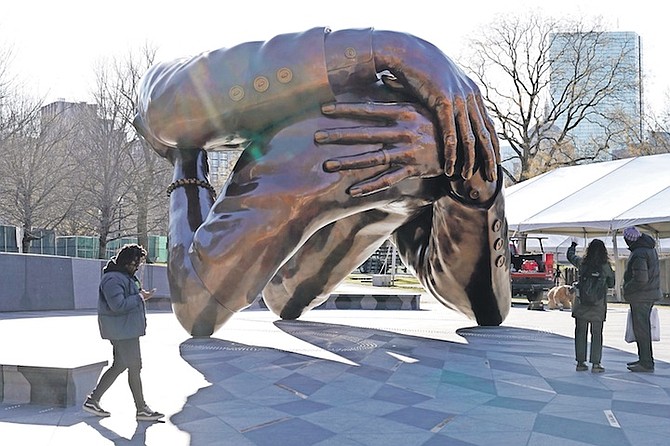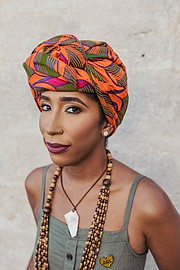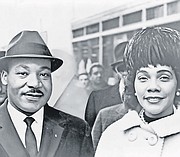PASSERS-by walk near the 20-foot-high bronze sculpture “The Embrace”, a memorial to Dr Martin Luther King Jr and Coretta Scott King, in the Boston Common, last week, in Boston. The sculpture, consisting of four intertwined arms, was inspired by a photo of the Kings embracing when MLK learned he had won the Nobel Peace Prize in 1964. Photo: Steven Senne/AP
ON January 13, a large bronze sculpture dedicated to Dr. Martin Luther King Jr. and Coretta Scott King was unveiled in Boston. Twenty feet long and 26 feet wide, titled “The Embrace”, it is meant to depict the Kings hugging, inspired by a photograph of the two after Dr King received the Nobel Peace Prize in 1964.
This description makes it seem like a great way to honour the couple and their civil rights leadership.
As videos from the unveiling circulated on social media, it became clear that the sculpture is not immediately recognisable as an embrace, much less the Kings.
Many shared that the sculpture looks like a different kind of embrace, sexual in nature.
The idea itself seemed like a good one. Both people would be represented, and the sculpture would show their love for one another.
As the photograph captured that moment, the sculpture would make it even more tangible, and seem to make their love for one another and pride in their work universal. Perhaps it could inspire others.
There are numerous messages to take away from such a work of art. That there is usually someone, often a woman, in the background whose work may go unnoticed, but makes the visible work possible.
That partnership is important. That we share in one another’s wins.
Unfortunately, nothing like that comes to mind when most people look at the sculpture, and it is not because of dirty minds. It is because the idea is not the same as what was brought to fruition. It does not have the intended effect.
One of the most troubling aspects of the sculpture is that there are no heads, so there are certainly no faces.
It is difficult to tell that it is depicting people — two people — so it is certainly not easy to determine who those people are.
Why would a sculpture in honour of civil rights leaders have parts of their bodies, but not their heads?
How did no one involved in the process challenge the idea that the heads of two black people who dedicated their lives to the civil rights movements be absent from the work?
Here is an issue of race, and a part of history and a context, that was not considered.
Black people continue to face violence today, from individuals and institutions, from harassment to lynching.
It does not make sense for Dr Martin Luther King Jr and Coretta Scott King to be headless in a sculpture depicting their embrace, honouring their work toward racial justice.
The artist wanted people to see the “universal” spirit of the piece. He kept it open so people could walk into it and be in the embrace. They could also look up and see the sky.
These are all interesting ideas. They simply do not, at this time, outweigh the appearance.
Maybe this will change over time, as people see it, already knowing what it is meant to depict. For now, some find it funny while others find it very upsetting.
There are takeaways from this situation. The first is that it is important, no matter how brilliant a person or idea, to get feedback from others. Who is this for? Who will make use of it? Who will find reasons to dislike it? Who will have platforms to talk about it and influence other people’s positions on it?
Find out not only if they like the idea, but if they can see it being executed and being received as it is intended.
Ask them to share what they would add or take away to make it better. Get real feedback that is not only honest, but useful. You have to be able to act on the information you are given.
The second takeaway is that what is proposed and modeled may not have the same appearance or effect when it is produced at a different scale and experienced from a different vantage point.
Holding a model or looking down at one on a table is not the same as looking up at the completed work. The relative size is wildly different, as is the perspective.
It is important to think more deeply and creatively about ways to model, pilot, and test in ways that help us to predict what the actual outcome and responses will be.
The third takeaway is that even the best intentions can have negative effects. It is not enough to want, to desire, to wish, or to try to produce something good, useful, beautiful, or effective when the outcome is harmful.
More important than intent is investment. How much time and other resources are put into planning? How much is invested in testing? What are producers prepared to do if the product is not effective?
At the end of the process, a confusing or offensive sculpture is made no better by a plaque that says, “We tried,” or “We meant to…”
Maybe “The Embrace” will spark great conversations. Maybe generations and generations of people will take photos inside it. Maybe people will stand in the middle, look up at the sky, and be inspired.
With art, there are many possibilities. For a sculpture meant to honour the Kings, however, more than their arms — easily mistaken for other body parts — should have been included, and their heads should have been included. To make their embrace a universal symbol was certainly a choice we can debate, but to reduce two black civil rights leaders to a headless gesture is a move that should have been strongly challenged, and could have spared everyone the confusion and offence.
Recommendations
1 Petty Crimes. Long-time friends and hosts Caera O’Sullivan and Griff Stark-Ennis share largely inconsequential disagreements and deliver a verdict. Try the episode titled “Bridezillith” for a story about a woman who was very nicely asked to be a bridesmaid by her brother’s fiancée and does not end up having a great time. This is the kind of podcast you may want to listen to when you need to step outside of your own reality and/ or be entertained by a “problem” no one should have the time to worry about.
2 Lizzo on Hot Ones. This interview series is fun to watch. Celebrities sit at a table, across from the interviewer, eating wings with hot sauces of elevating heat levels. They answer questions between bites, so it is very difficult for them to hide how they handle the heat. Lizzo talks a big game, determined to win. They are times when she has to pause in her answers, but she assures viewers that she will make it to the end.
3 Women’s Wednesdays: Femicide. At 6pm, tune in to the conversation, facilitated by Equality Bahamas, with Mexico-based independent journalist Chantal Flores (who investigates the impact of enforced disappearance on women in Latin America and the Balkans) and Dr Nadeen Spence who is on the National Strategic Action Plan against Gender Based Violence, the National Gender Advisory Council, and the Partnership for Jamaica. They will talk about femicide in Latin America and in the Caribbean, the way news media reports on femicide, and action at the national level to end femicide. It will be live-streamed at Facebook.com/ equality242.







Comments
Sickened 1 year, 3 months ago
Ahhh... beautiful! Maybe? I guess. In a way, perhaps.
Sign in to comment
Or login with:
OpenID